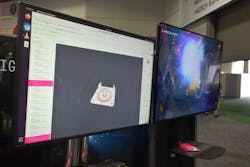First-time FABTECH exhibitor Abagy Robotic Systems has an ambitious goal: to revolutionize the industrial robotics market by extending robots' applicability to non-serial production. Indeed, Abagy representatives emphasized that the "key trend" at Fabtech was the robotization of high-mix, low-volume production—especially with skilled workers hard to come by.
“If you're doing a serial [weld]—like what you see in the automotive industry, where it's the same part being welded over and over and over again—we've been doing that for decades, and that's been using robots,” David Suttle, Abagy director of sales, told TBB during a booth visit. “But for real high mix, low and medium volume, it's been really hard to justify the ROI.”
The challenge—the complications and the cost—is based on programming or training the robot to position the welder around the part. The commonly used “teach pendant” has been the “Achilles heel” for this type of robotic welding, especially for those high-mix, low-volume production runs, Suttle explained. Additionally, real production differs from ideal blueprints—but robots operate with almost zero tolerance for any deviations in the workpiece or its position.
The Abagy system, however, is computer-vision-based and AI-enabled software for no-code, on-the-fly industrial robot programming. Ababy automatically generates a robot program to produce a specific product, and it takes just minutes, according to the company. Using machine vision, the system scans the parts and adjusts the robot's trajectories depending on the actual position and deviations of the product.
“If you need to make modifications, like a stitch weld, or you want to do the standoff a little different, all those things are simply point and click,” Suttle said. “You never have to put in XYZ coordinates, never have to put in speeds and feeds. Once you've just told the model what you want to do, then you put your part down. We simply don't need any perfect positioning and we don't need any elaborate fixtures. We have a couple of clamps to hold it the part in place so it doesn't move when it's being welded. Then hit the Go button.”
During Fabtech 2022, more than two tons of metal were used by ABAGY’s team and the guests to demonstrate the opportunities of AI & machine vision algorithms in welding. The live welding demonstration was performed at ABAGY’s booth.
“It's really exciting to see how quickly the ABAGY team is advancing the technology," Jon Karr, vice-president at FANUC America, said. "I think, high-mix, low-volume production is exactly where this technology shines. We work a lot with the automotive business, and our customers need this technology”.
Abagy's Suttle noted that the company has received a “huge amount of interest” from trailer builders and other transportation equipment manufacturers. He encouraged TBB readers to visit the Abagy YouTube channel (@ABAGY) for range of demonstration projects.
Visit abagy.com for more information.
About the Author
Kevin Jones
Editor
Kevin has served as editor-in-chief of Trailer/Body Builders magazine since 2017—just the third editor in the magazine’s 60 years. He is also editorial director for Endeavor Business Media’s Commercial Vehicle group, which includes FleetOwner, Bulk Transporter, Refrigerated Transporter, American Trucker, and Fleet Maintenance magazines and websites.
Working from Beaufort, S.C., Kevin has covered trucking and manufacturing for nearly 20 years. His writing and commentary about the trucking industry and, previously, business and government, has been recognized with numerous state, regional, and national journalism awards.

